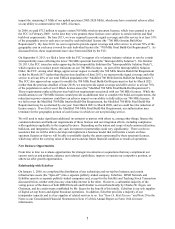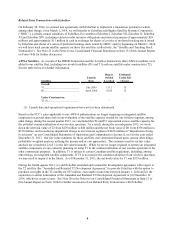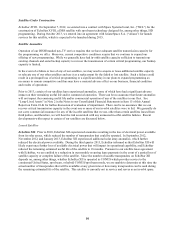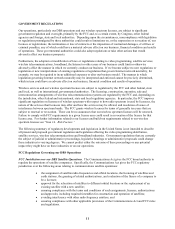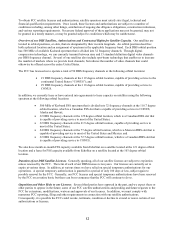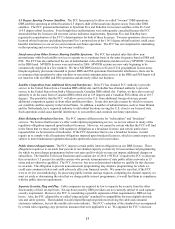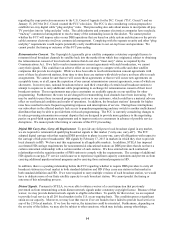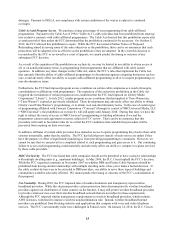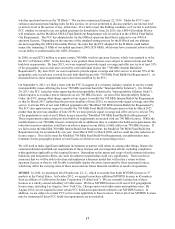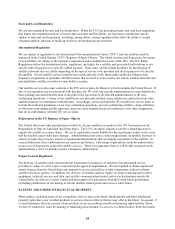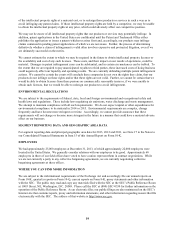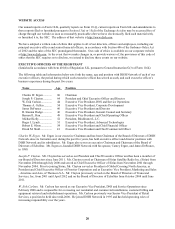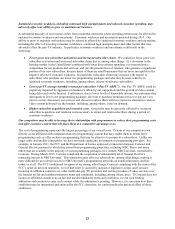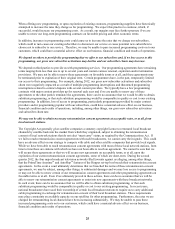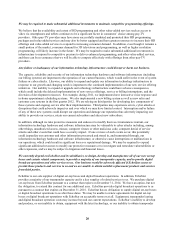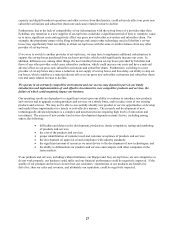Dish Network 2013 Annual Report Download - page 27
Download and view the complete annual report
Please find page 27 of the 2013 Dish Network annual report below. You can navigate through the pages in the report by either clicking on the pages listed below, or by using the keyword search tool below to find specific information within the annual report.17
17
wireless spectrum known as the “H Block.” The auction commenced January 22, 2014. Under the FCC’s anti-
collusion and anonymous bidding rules for this auction, we are not permitted to disclose publicly our interest level
or activity level in the auction, if any, at this time. If we fail to meet this bidding condition, or if we fail to notify the
FCC whether we intend to use our uplink spectrum for downlink by June 20, 2016, the AWS-4 Downlink Waiver
will terminate, and the Modified AWS-4 Final Build-Out Requirement will revert back to the AWS-4 Final Build-
Out Requirement. The FCC has adopted rules for the H Block spectrum band that is adjacent to our AWS-4
spectrum licenses. Depending on the outcome of the standard-setting process for the H Block and our ultimate
decision regarding the AWS-4 Downlink Waiver, the rules that the FCC adopted for the H Block could further
impact the remaining 15 MHz of our uplink spectrum (2005-2020 MHz), which may have a material adverse effect
on our ability to commercialize the AWS-4 licenses.
In 2008, we paid $712 million to acquire certain 700 MHz wireless spectrum licenses, which were granted to us by
the FCC in February 2009. At the time they were granted, these licenses were subject to certain interim and final
build-out requirements. By June 2013, we were required to provide signal coverage and offer service to at least 35%
of the geographic area in each area covered by each individual license (the “700 MHz Interim Build-Out
Requirement”). By June 2019, we were required to provide signal coverage and offer service to at least 70% of the
geographic area in each area covered by each individual license (the “700 MHz Final Build-Out Requirement”). As
discussed below, these requirements have since been modified by the FCC.
On September 9, 2013, we filed a letter with the FCC in support of a voluntary industry solution to resolve certain
interoperability issues affecting the lower 700 MHz spectrum band (the “Interoperability Solution”). On October
29, 2013, the FCC issued an order approving the Interoperability Solution (the “Interoperability Solution Order”),
which requires us to reduce power emissions on our 700 MHz licenses. As part of the Interoperability Solution
Order, the FCC, among other things, approved our request to modify the 700 MHz Interim Build-Out Requirement
so that by March 2017 (rather than the previous deadline of June 2013), we must provide signal coverage and offer
service to at least 40% of our total E Block population (the “Modified 700 MHz Interim Build-Out Requirement”).
The FCC also approved our request to modify the 700 MHz Final Build-Out Requirement so that by March 2021
(rather than the previous deadline of June 2019), we must provide signal coverage and offer service to at least 70%
of the population in each of our E Block license areas (the “Modified 700 MHz Final Build-Out Requirement”).
These requirements replaced the previous build-out requirements associated with our 700 MHz licenses. While the
modifications to our 700 MHz licenses would provide us additional time to complete the build-out requirements, the
reduction in power emissions could have an adverse impact on our ability to fully utilize our 700 MHz licenses. If
we fail to meet the Modified 700 MHz Interim Build-Out Requirement, the Modified 700 MHz Final Build-Out
Requirement may be accelerated by one year, from March 2021 to March 2020, and we could face the reduction of
license area(s). If we fail to meet the Modified 700 MHz Final Build-Out Requirement, our authorization may
terminate for the geographic portion of each license in which we are not providing service.
We will need to make significant additional investments or partner with others to, among other things, finance the
commercialization and build-out requirements of these licenses and our integration efforts, including compliance
with regulations applicable to the acquired licenses. Depending on the nature and scope of such commercialization,
build-out, and integration efforts, any such investment or partnership could vary significantly. There can be no
assurance that we will be able to develop and implement a business model that will realize a return on these
spectrum licenses or that we will be able to profitably deploy the assets represented by these spectrum licenses,
which may affect the carrying value of these assets and our future financial condition or results of operations.
MVDDS. In 2010, we purchased all of South.com, L.L.C., which is an entity that holds MVDDS licenses in 37
markets in the United States. In October 2012, we agreed to purchase additional MVDDS licenses in 45 markets
from an affiliate of Cablevision Systems Corporation (“Cablevision”). We are currently leasing four of these
licenses to a wholly-owned subsidiary of Cablevision. We have MVDDS licenses in 82 out of 214 geographical
license areas, including Los Angeles, New York City, Chicago and several other major metropolitan areas. By
August 2014, we are required to meet certain FCC build-out requirements related to our MVDDS licenses. In
addition, we are subject to certain FCC service rules applicable to these licenses. Part or all of our MVDDS licenses
may be terminated if these FCC build-out requirements are not satisfied.


